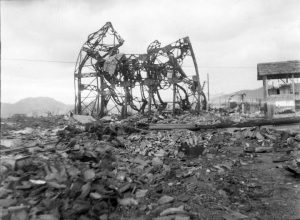Documenting Hiroshima of 1945: December 11, 20-year-old Onomichi man takes photos of Hiroshima tragedy
Dec. 11, 2024
by Kyosuke Mizukawa, Senior Staff Writer
On December 11, 1945, Tsutae Hirahara, 20 at the time, who lived in Onomichi City in Hiroshima Prefecture, visited Hiroshima City with his camera in hand. Mr. Hirahara was an employee at the Onomichi Branch of the Chugoku Haiden power company (present-day Chugoku Electric Power Co.). For him, Hiroshima was a place full of memories where he had spent two years living in a dormitory for training.
“Out of my personal curiosity to understand how the formerly big city of Hiroshima had changed after the atomic bombing, I came up the idea of taking photographs, but it was difficult to get my hands on any film.” Responding to an interview from the Chugoku Shimbun in August two years ago, when he was 97 years of age, Mr. Hirahara revealed his struggles.
At the time of the atomic bombing, Mr. Hirahara had been conscripted by the military and was serving in a unit in the Kyushu region. On August 18, following the declaration of the end of the war, he was returning to Onomichi City after his service in a unit in Matsue City in Shimane Prefecture when he came up with the idea of taking photos of Hiroshima. On the train he was riding, he had been shocked to hear about Hiroshima’s situation from a woman on the same train who happened to have been in the city. He said, “When I asked about the city, she told me it had been reduced to ashes, and when I asked about the Chugoku Haiden power company, she surprisingly replied, ‘It’s probably gone.’”
However, due to goods shortages, Mr. Hirahara was unable to get his hands on any film. One day, he received information that someone affiliated with the Onomichi Branch of his company had film, which made him think of bartering goods. He offered sweet potatoes for the trade. He said, “At that time, sweet potatoes were valuable amid the food shortages. Because my parents were farmers, I was able to provide plenty of sweet potatoes.”
With the film he received through the trade, Mr. Hirahara took photos of the tragedy that had befallen the city. “While pressing the shutter, I thought ‘how terrible.’” The Chugoku Haiden’s head office building, located in the area of Komachi (in Hiroshima’s present-day Naka Ward), had maintained its shape, but the interior was burned out. Ebisu-cho (also in Naka Ward) and the surrounding areas had also been incinerated. When he was living in the dormitory, he used to visit movie theaters and musical instrument shops in the shopping streets of that area.
Mr. Hirahara underwent the interview by the Chugoku Shimbun at a time when few photographers who took A-bomb photos were alive and in good health. In front of 13 photographic prints he kept at home, he said, “In any case, I hate war.” Four months later, in December 2022, Mr. Hirahara passed away.
(Originally published on December 11, 2024)
On December 11, 1945, Tsutae Hirahara, 20 at the time, who lived in Onomichi City in Hiroshima Prefecture, visited Hiroshima City with his camera in hand. Mr. Hirahara was an employee at the Onomichi Branch of the Chugoku Haiden power company (present-day Chugoku Electric Power Co.). For him, Hiroshima was a place full of memories where he had spent two years living in a dormitory for training.
“Out of my personal curiosity to understand how the formerly big city of Hiroshima had changed after the atomic bombing, I came up the idea of taking photographs, but it was difficult to get my hands on any film.” Responding to an interview from the Chugoku Shimbun in August two years ago, when he was 97 years of age, Mr. Hirahara revealed his struggles.
At the time of the atomic bombing, Mr. Hirahara had been conscripted by the military and was serving in a unit in the Kyushu region. On August 18, following the declaration of the end of the war, he was returning to Onomichi City after his service in a unit in Matsue City in Shimane Prefecture when he came up with the idea of taking photos of Hiroshima. On the train he was riding, he had been shocked to hear about Hiroshima’s situation from a woman on the same train who happened to have been in the city. He said, “When I asked about the city, she told me it had been reduced to ashes, and when I asked about the Chugoku Haiden power company, she surprisingly replied, ‘It’s probably gone.’”
However, due to goods shortages, Mr. Hirahara was unable to get his hands on any film. One day, he received information that someone affiliated with the Onomichi Branch of his company had film, which made him think of bartering goods. He offered sweet potatoes for the trade. He said, “At that time, sweet potatoes were valuable amid the food shortages. Because my parents were farmers, I was able to provide plenty of sweet potatoes.”
With the film he received through the trade, Mr. Hirahara took photos of the tragedy that had befallen the city. “While pressing the shutter, I thought ‘how terrible.’” The Chugoku Haiden’s head office building, located in the area of Komachi (in Hiroshima’s present-day Naka Ward), had maintained its shape, but the interior was burned out. Ebisu-cho (also in Naka Ward) and the surrounding areas had also been incinerated. When he was living in the dormitory, he used to visit movie theaters and musical instrument shops in the shopping streets of that area.
Mr. Hirahara underwent the interview by the Chugoku Shimbun at a time when few photographers who took A-bomb photos were alive and in good health. In front of 13 photographic prints he kept at home, he said, “In any case, I hate war.” Four months later, in December 2022, Mr. Hirahara passed away.
(Originally published on December 11, 2024)








